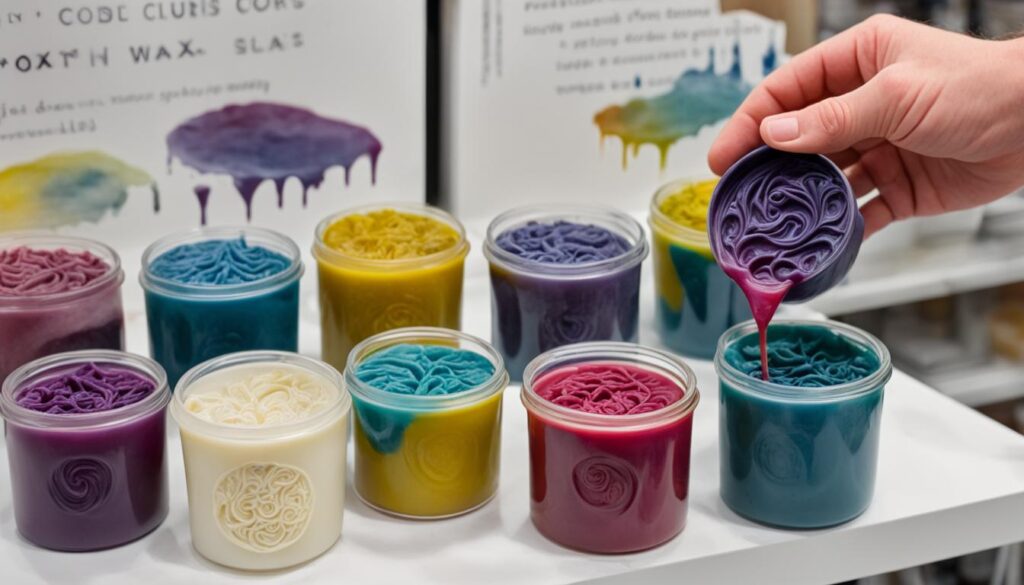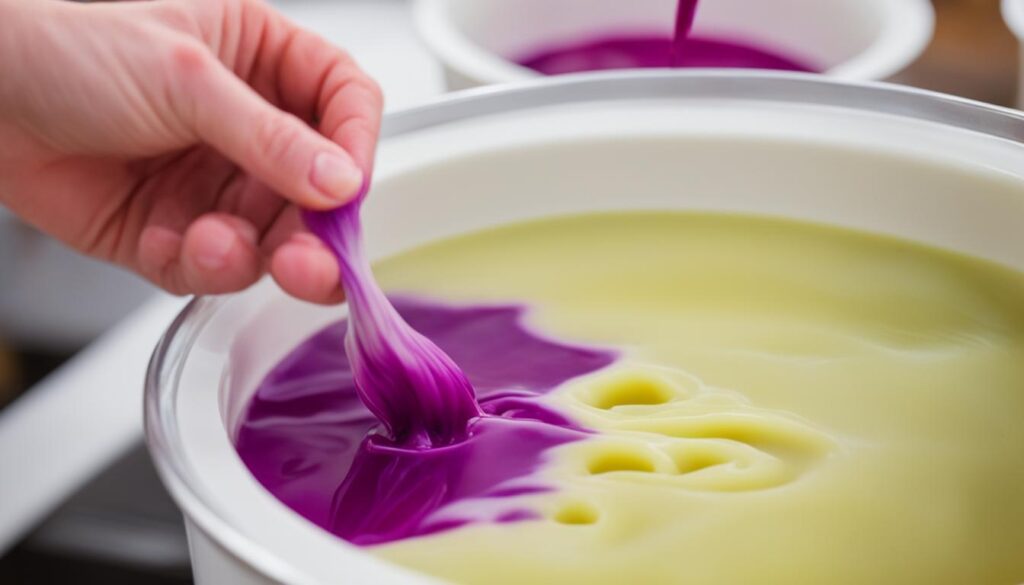Using Natural Dyes and Pigments in Candle Making
Imagine making candles that are both beautiful and kind to the planet. What if you could turn plants, flowers, and minerals into colors for your candles? This is the magic of natural dyes and pigments in candle making.
Learn how to make candles that look great and are good for the earth. We’ll show you how to use natural dyes and pigments to make your candle-making special. It’s a way to celebrate nature’s beauty.
Key Takeaways
- Unlock the vibrant potential of natural dyes and pigments for your candle creations.
- Discover the benefits of using eco-friendly, plant-based coloring for your candles.
- Explore the diverse range of natural dye sources and their unique characteristics.
- Learn how to incorporate natural dyes and pigments into your candle-making process.
- Unleash your creativity and elevate your candle designs with the beauty of nature.
Ever thought about What are the best natural dyes and pigments to use for candle making, and how can they enhance the overall aesthetic and sustainability of your creations? Let’s dive into the world of natural candle dyes and pigments to find out.
Introduction to Natural Candle Dyes
Natural dyes are a great choice for eco-friendly candle making. They come from plants, insects, or minerals. Natural dyes for candle making are sustainable and can give your candles vibrant colors.
Benefits of Using Natural Dyes
Natural dyes are good for the planet. They break down easily, are safe, and can be renewed. This makes them a better choice for eco-friendly candle coloring. They are also gentler on the environment and don’t harm air quality as much as synthetic dyes.
Popular Natural Dye Sources
There are many popular natural dye ingredients for candle making. Some top choices include:
- Cochineal (derived from insects)
- Indigo (a plant-based blue dye)
- Annatto seeds (yielding warm, golden tones)
- Alkanet root (producing deep, rich reds)
- Madder root (creating vibrant red hues)
- Spirulina (a blue-green algae)
- Nettles (offering earthy, green-toned dyes)
These natural colors can turn your candles into beautiful pieces of art. Each one has its own special look and feel.
“Natural dyes are not only beautiful, but they also offer a more sustainable and eco-friendly way to color our candles.”
Cochineal: A Vibrant Insect-Derived Dye
As a candle maker, you might know the cochineal dye for candles. It comes from the dried female cochineal insects that live on cactus plants. This dye is great for making natural candle colors because it creates beautiful red, pink, and coral shades.
Cochineal is special because it’s made from insects. It’s a natural option that has been used for hundreds of years. In candle making, it turns your candles into eye-catching pieces with a vibrant red color.
“Cochineal dye is a rich, natural pigment that can infuse your candles with a vibrant, regal hue.”
Brands like Zecchi and Schmincke offer high-quality cochineal pigments. These are ideal for adding color to your candle wax. Cochineal’s deep colors make it a top choice for candle makers who want bold, artistic designs.
Trying out natural dyes like cochineal can expand your creative options in candle making. This insect-based pigment adds beauty and uniqueness to your candles. Let it inspire you to make your next batch of candles stand out.
Indigo: The Ancient Blue Dye
Indigo has been a fascinating natural dye for centuries. Its deep, vibrant blue color has captured the hearts of many. This ancient pigment comes from the indigo plant’s leaves and stems. It has a long history that crosses continents and cultures.
Historical Background of Indigo
Indigo first grew in southern China and the Indochina Peninsula. It was more popular than synthetic dyes for a long time. The indigo plant makes a deep, lasting blue color. This made it very valuable, and it was traded across Asia, Africa, and Europe.
Indigo Dyeing Process for Candles
In candle making, indigo pigments make beautiful, cornflower blue colors. The dyeing process involves soaking the indigo in melted wax for a long time. This lets the color fully soak in and create a vibrant, natural blue candle dye.
This method uses the power of indigo dye for candles. It brings the rich history of this natural pigment to life. The result is stunning, natural blue candle dye.
“Indigo has long been prized for its ability to produce a deep, lasting blue color, making it a highly sought-after natural dye throughout history.”
Preparing Materials for Natural Candle Making
Starting with natural candle making means picking the right materials and tools. You’ll need top-notch natural wax, bright natural colorants, and more. This list includes cooking pots, beakers, paper cups for molds, empty bottles, natural candle wicks, wooden sticks, a dispensing spoon, a glass rod, and an induction cooktop. Always be careful to avoid burns when working with fire.
The materials for natural candle making let you express your creativity. The right natural dyes and pigments can turn a basic candle into art. Try different natural candle dyes from plants, insects, or minerals to get the colors you want.
- High-quality natural wax (such as soy, beeswax, or coconut wax)
- Vibrant natural colorants (e.g., cochineal, indigo, turmeric, spirulina)
- Cooking pots and beakers for melting and mixing
- Paper cups or empty bottles for molds
- Natural cotton or hemp candle wicks
- Wooden sticks for stirring and shaping
- Dispensing spoon and glass rod for precise pouring and mixing
- Induction cooktop or double boiler for controlled heating
With the essential tools for natural candle dyes and creativity, you’re set to make stunning, eco-friendly candles. These candles will highlight nature’s beauty.
Melting Wax and Adding Natural Dyes
Making natural candles starts with melting the wax and adding dyes. It’s important to get the temperature, wax, and pigments just right. This ensures the color and consistency you want.
Temperature Considerations
The best temperature for melting candle wax is between 50°C and 60°C. But, you can heat it up to 70-75°C for a better finish. After melting, add natural pigments and stir well to mix in the color.
Incorporating Effect Pigments
- You can use natural dyes or try pigments like Metashine Silver Coat MC5090PS and 153 Flash Pearl for special effects in your melting wax for natural candles.
- These pigments add depth and elegance to your natural candle dyes, making your candles stand out.
- When adding pigments, make sure they mix well with the temperature for natural candle dyes. This ensures a beautiful, even color.
Learning to melt wax and add natural dyes and pigments opens up many creative possibilities. Let your creativity shine and explore new ideas!
Pouring and Molding Naturally Dyed Candles
Making beautiful natural candles is all about pouring and molding. Start by pouring the melted, pouring natural candle wax into your molds. Use paper cups or candle jars, and make sure not to touch the candle wicks. This method lets you make candles with unique, multi-layered molding natural candle designs.
Let the wax harden completely before moving on. This usually takes 1-2 hours at room temperature. Waiting patiently helps you add more colors later. By controlling how you pour and mold, you can create many different candles with natural colors.
- Prepare your molds or containers, ensuring they are clean and dry.
- Gently pour the melted, dyed wax into the molds, being careful not to disrupt the candle wicks.
- Allow the wax to cool and harden completely, which can take 1-2 hours at room temperature.
- Optionally, add additional layers of color by pouring more dyed wax on top of the hardened base.
- Once the candles are fully set, remove them from the molds and admire your unique, naturally colored creations.
| Pouring Tips | Molding Techniques |
|---|---|
|
|
With patience and care, you can make unique, naturally dyed candles. These candles add artistry to any space. Enjoy the pouring natural candle wax and molding natural candle designs process. Let your creativity show.

Lina Blue: A Plant-Based Natural Dye
As candle lovers look for greener options, lina blue natural dye is gaining attention. It comes from Spirulina, a type of algae that’s safe to eat. It’s okay to use in the U.S., Europe, Japan, Korea, and Taiwan.
Plant-based blue candle dye like lina blue is loved for its natural roots and beautiful blue color. But, lina blue has some limits that candle makers should know about.
Limitations of Lina Blue
Lina blue fades easily when it’s in the light, which is a big drawback. It also can’t handle high heat well. This is a problem for candle makers who use hot waxes.
- Lina blue’s color may fade when exposed to light
- Lina blue’s heat resistance is limited, making it challenging to use with high-temperature waxes
- Thorough testing is recommended before incorporating lina blue into candle-making projects
Even with its limits, lina blue is still a good choice for eco-friendly candles. By knowing its pros and cons, candle makers can make better choices. They can also find creative ways to use this natural dye.
natural dyes for candle making
Exploring natural dyes can open up new possibilities for candle making. You can turn your candles into eco-friendly works of art. There are many plant-based ingredients to choose from.
Madder root gives candles a peach color. Alkanet root makes them burgundy-red. Annatto seeds add a warm, golden-yellow shade. Spirulina turns them a stunning green.
These natural dyes give your candles eco-friendly colors. They also connect you to nature.
Using plant-based candle dyes makes your candles beautiful and safe. They are free from harmful synthetic additives. These natural dyes for candle making are great for both hobbyists and professionals.
“Bringing the beauty of nature into your candles is a true act of artistry.”
Infusing Soy Wax with Natural Dyes
Infusing soy wax with natural dyes is a fascinating art in candle making. It’s a way to bring out the vibrant colors of nature. By carefully controlling the process, you can make your candles look stunning.
Infusion Methods and Duration
To start, pick your natural dye ingredients and put them in a heat-safe container like a tea bag or coffee filter. Then, put this into your melted soy wax, keeping the temperature between 130-140°F. The longer it steeps, the deeper the colors will be.
A good infusion time is 1-6 hours for the best colors. This method brings out vibrant, earthy colors that make your candles stand out. With a bit of practice, you’ll get great at infusing soy wax with natural dyes.

“The true beauty of natural dyes lies in their ability to imbue our creations with the essence of the earth itself.”
Alternative Methods for Coloring Candles
If you don’t have natural dyes or prefer an easier option, there are other ways to color your candles. You can use commercial candle color chips or crayons for a quick and simple way to add color. These methods make it easy to get vibrant, consistent colors for your candles.
Using Candle Color Chips
Candle color chips are a top pick for adding color fast and easy. They are made to be added right to melted wax. This gives your candle a consistent color all the way through. With many colors to choose from, they’re a great choice when you’re in a hurry or don’t have natural dyes.
Coloring with Crayons
Using crayons is another way to color candles. Pick crayon colors that match the shade you want for your candle and mix them into the melted wax. But remember, crayons might change how the candle burns. This is because wax and crayon pigments might not mix well. Always test small amounts first before making more candles.
Choosing between color chips or crayons gives you easy options when natural dyes aren’t an option. Try different methods and see what works best for you and your candle making.
| Method | Advantages | Considerations |
|---|---|---|
| Candle Color Chips |
|
|
| Crayons |
|
|
Safety Considerations and Precautions
Working with natural dyes and pigments for candle making requires safety first. Some colorants, like those with heavy metals, can release harmful fumes when heated. Always check the safety of any natural ingredients before adding them to your candles.
It’s important to know that natural colors can fade when exposed to light. To stop this, keep your candles in a dark spot, away from sunlight or bright lights.
- Do your homework on the safety and stability of any natural dyes or pigments before making candles with them.
- Watch out for toxic fumes from heating certain natural colorants and make sure your workspace is well-ventilated.
- Keep your candles with natural dyes in a dark, cool place to avoid color fading.
By focusing on safety for natural candle making and being careful with natural candle dyes, you can make lovely, eco-friendly candles. These candles will be safe for you and your family to enjoy. Understanding how to work with natural materials makes candle making rewarding and successful.
“Embracing the beauty of nature in your candle creations starts with a deep respect for safety and responsible practices.”
Conclusion
Using natural dyes and pigments in candle making makes your candles eco-friendly and vibrant. They don’t have synthetic additives. You can choose from many colors, like bold cochineal reds to calm indigo blues.
These natural colors come from plants and insects. They let you make candles that are unique and sustainable. You can use soy wax, beeswax, and paraffin to make your candles.
Adding these natural dyes to your candles is good for the planet. It also makes your candles stand out. Start using natural candle dyes to make your candles truly special and eco-friendly.
If you’re new or experienced in candle making, natural dyes are exciting to try. They let you bring out the best in your creations. Let nature’s colors make your candles shine.
FAQ
What are the benefits of using natural dyes for candle making?
What are some popular natural dye sources for candle making?
How does cochineal dye work for coloring candles?
What is the process for using indigo to dye candles?
What materials and tools are needed for making naturally dyed candles?
What are some considerations when using Lina Blue, a plant-based blue colorant, for candle making?
How can soy wax be infused with natural dyes?
What are some alternative methods for coloring candles if natural dyes are not available?
What safety considerations should be taken when working with natural dyes and pigments for candle making?
Source Links
- https://www.revivalhomesteadsupply.com/blog/coloring-soy-wax-with-natural-dyes-1 – Coloring Soy Wax with Natural Dyes — Revival Homestead Supply
- https://www.thesprucecrafts.com/infuse-natural-colors-in-candles-517204 – Learn How to Infuse Natural Colors Into Your Soy Candles
- https://pigment.tokyo/en/blogs/article/candle – Candles Made with Colors Derived from Nature | Pigment Tokyo
- Fragrance That Wows: A Beginner’s Guide to Adding Scents to Your Homemade Candles
- best essential oils for candles
- wood wick guide
- how to make candles smell stronger
- how to ship candles
- how to fix soy wax frosting
- wick Guide how to choose the right wick size with chart
- how to make candle molds
- how to clean candle wax
- how to reuse candle jars
- soy wax candle troubleshooting
- best wax melter for candle making
- how to conduct burn test
- why candle flickering crackling smoking
- how much wax per candle
- how to make candles smell stronger
- Easy Ways to Increase the Scent Throw of Your DIY Candles
- How to Make Candles for Meditation and Relaxation
- Using Upcycled Materials in Candle Making
- How to Make Hand-Poured Candles: Tips and Techniques

Leave a Reply